Be social! Share the fun!
2022 Anteprime Toscana

Official Welcome Dinner of Anteprime di Toscana 2022 March 19
Official Welcome Dinner of Anteprime di Toscana 2022
Words can’t describe the thrill of walking toward the entrance of the Palazzo Vecchio for the welcome dinner of Anteprime di Toscana 2022.
It would be the first time international wine journalists and Tuscan producers would see one another in the two long years since COVID, and everyone appeared in a mood of celebration.
Michelangelo’s David Giving a Warm Welcome
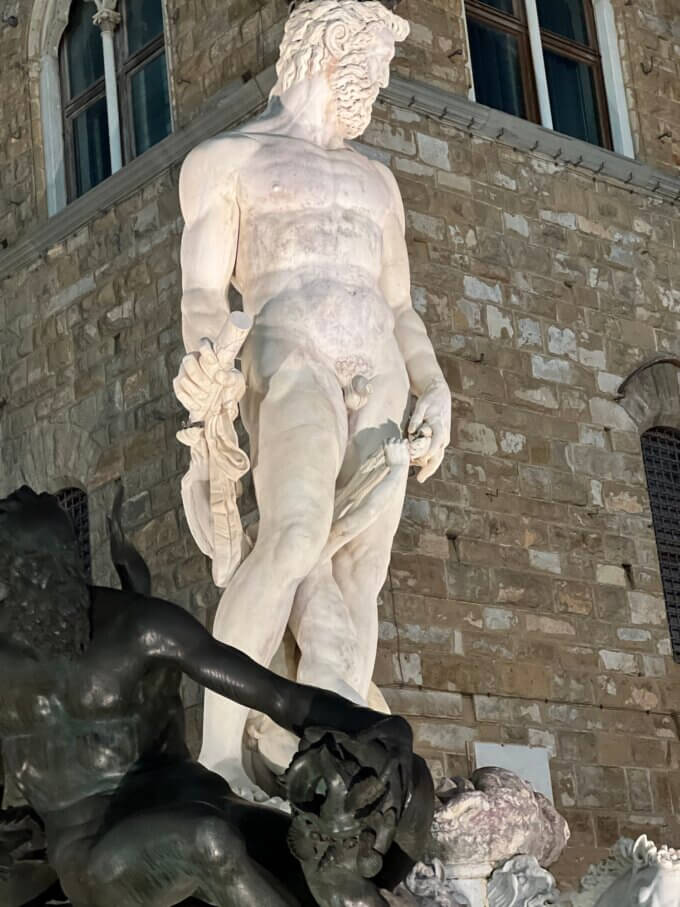
Even before I approached the red-carpet leading to the Palazzo Vecchio entrance, an enormous recreation of Michelangelo’s “David” greeted me outside in the brisk spring air. I could almost detect a friendly smile on the statue’s face and even a wink, welcoming me to the festivities inside.
With a sense of excitement, I passed through the two gilded lions guarding the palace.
Stepping into the Palazzo Vecchio
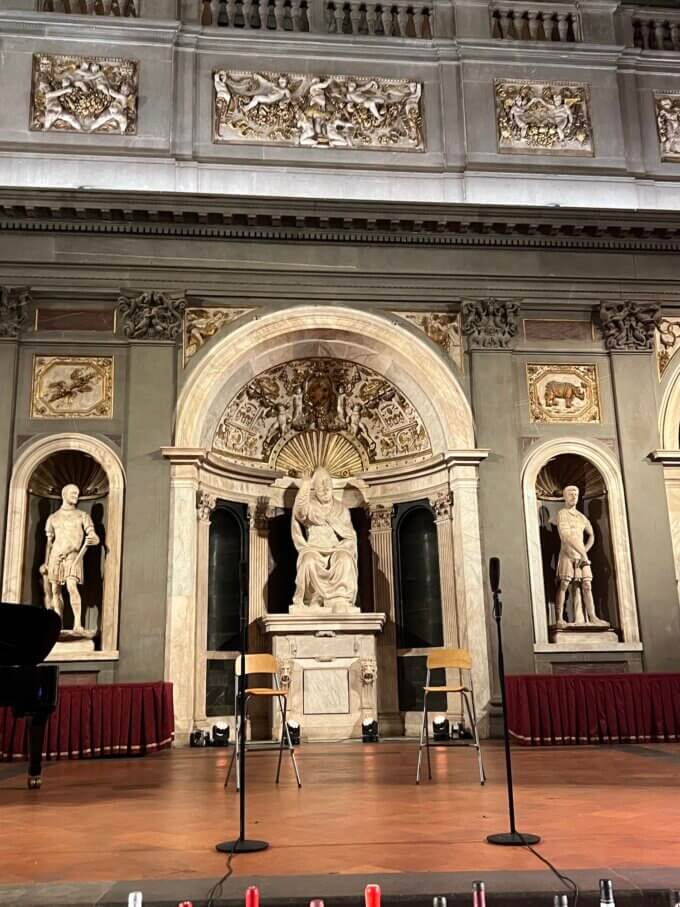
When it comes to literally rolling out the red carpet, it’s hard to rival the Florentines. The magnificence of this palace defies words. Let’s just say that once I stepped up to the ground floor, the sumptuous setting completely dazzled me.
The idea for the Palazzo Vecchio was born in 1299, when the people of Florence built a palace worthy of the city’s importance.
Of course, the good people of Florence might have also been looking forward to the day when their Tuscan wine would be of international importance.
At least, I’d like to think so.
The organizers behind the Anteprime di Toscana 2022 must have thought so too, for the magnificent cuisine, delicious Tuscan wine, and curated entertainment befitted a royal banquet.
Structure of the Evening
At 7pm, the doors to the magnificent “Salone dei Cinquecento” opened. Producers and wine journalists who haven’t seen one another for over 1,000 days gathered with hugs of delight. Swirling among them were the organizers and representatives of the many Consorzios who would attend and hosting events during the next several days.
People were free to seat themselves at the round tables of eight. Many of my colleagues sat with familiar faces from their own country, city, or even neighborhood. I took it upon myself to sit with a delightful group of foreign strangers who soon became friends. Among them sat a Russian-born journalist named Tatiana Trostnikova who now lives in Florence.
Beside her was her colleague, also now living in Florence but originally from Japan. Other people at my table included Italian producers and Italian journalist who only spoke Italian.
The Evening Kick-off

The Master of Ceremonies for Anteprime Toscana kicked off the evening with an interview. Sitting on a stool beside him was Gianna Nannini, a very famous Italian singer-songwriter and musician.
Gianna easily charmed everyone in the crowd with her wit and humor. Even though Italian isn’t my strongest language, I could easily understand the sections in which she spoke about the childhood memories which led her to create her wine brand based in her family’s Tuscan estate, Certosa di Belriguardo.
Musical Entertainment

Throughout the evening, the most talented students of the “Maggio Musicale Fiorentino” sang Opera, adding to the sumptuous delight of the evening.
Listening to the passionate music, and looking at the gilded frescos and ceilings on the walls of the Salone dei Cinquecento I closed my eyes to imagine all the drama that must have occurred in this very room over the past near-thousand years.
The Wine and the Dinner Courses
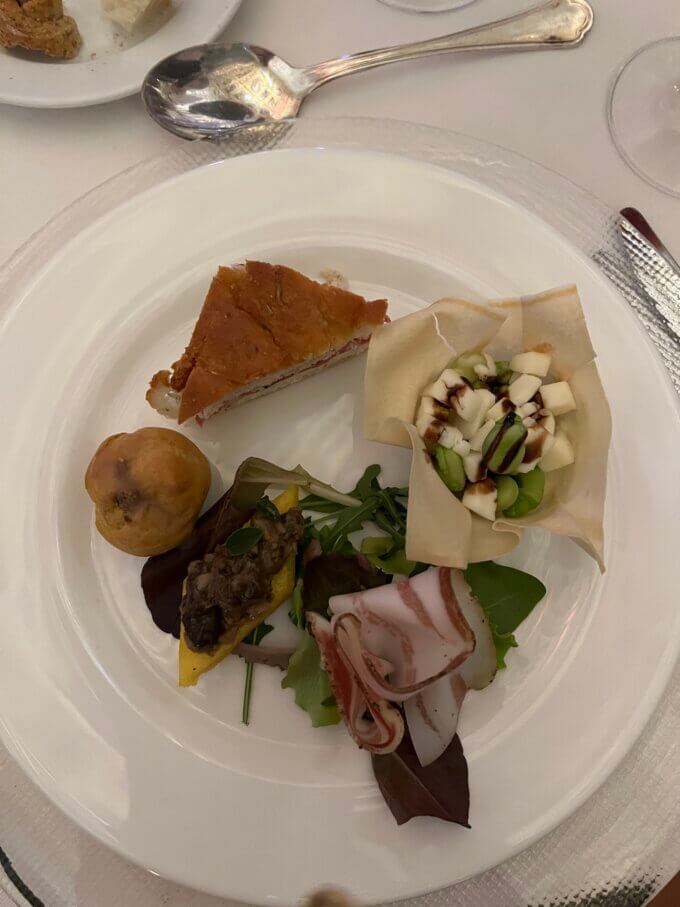
Every table enjoyed a series of signature Italian wines from the Tuscan region, including Vin Santo.
The first plate was a mix of traditional favorites presented in a new way.
Then we had a recreation of traditional pasta styles, followed by a meat course, and finally dessert.
March 20 Chianti Lovers & Rosso Morello

This event, like many of the events created by the people behind Anteprime Toscana, took place at a 14th century fort, Fortezza da Basso.
Colorful flags welcomed journalists here to taste the delicious wine of Chianti, outside the specified region of Chianti Classico, and Rosso Morellino.

New Vintages of Chianti and Morellino di Scansano
On display were the new vintages of Chianti DOCG 2021, Superiore 2020 and Riserva 2019, released in 2022. Also Morellino di Scansano DOCG 2021 and Riserva 2019, released in 2022.
I spent my time talking to various producers and hearing their stories about how they are involved with the wine before their table.
Meeting the Producers
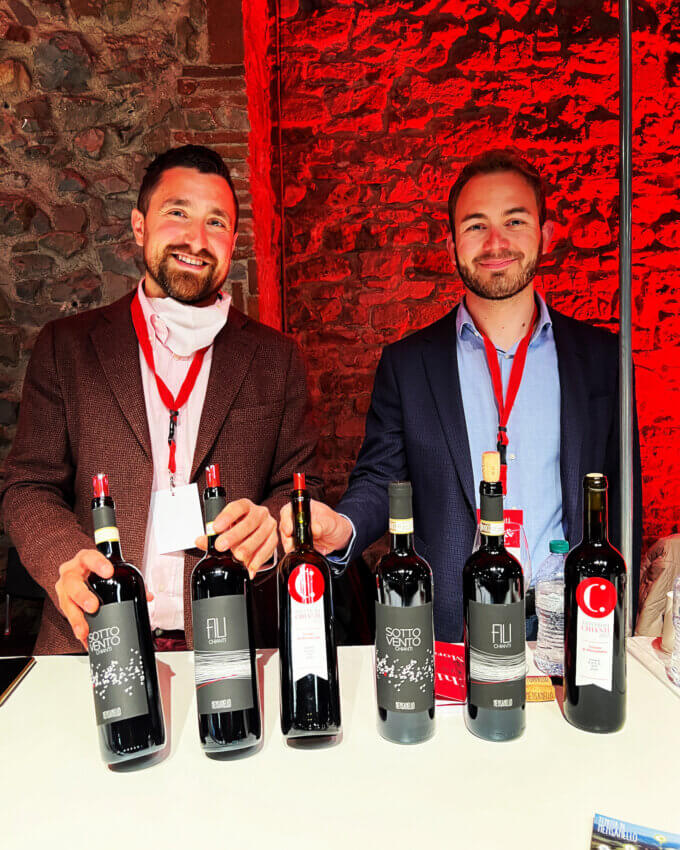
I spent my time talking to various producers and hearing their stories about how they are involved with the wine before their table.
One of the more interesting stories I heard was that of the ”professor,” a thirtysomething sharply dressed man who had until recently been employed by the University of Pisa. Today is the proprietor of Tenuta di Manenello, a winery, a restaurant, and agriturismo.
How did the professor get there?
“It all began with my uncle Filip,” he says. “My dad and uncle Fili worked in the vineyards on weekends, and I helped out as a kid. I graduated from university and became a professor in Pisa.
When my uncle passed, I took it over with my girlfriend. She helped me start the restaurant. We’re doing well as an agriturismo, with many tourists from northern countries. He named one of his wines Sotto Vento for his Uncle Fili.”
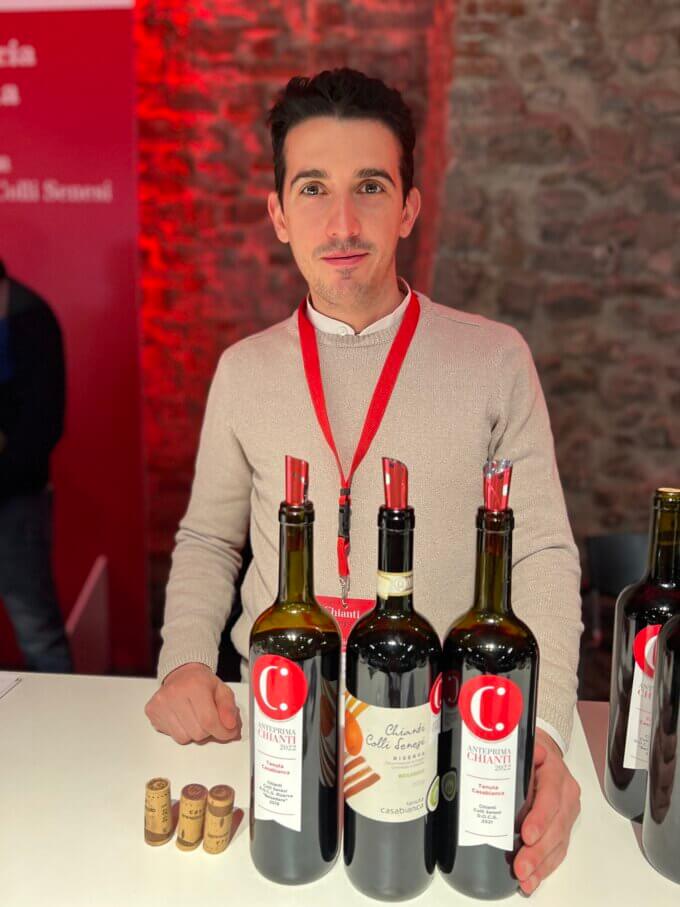
During the event, I met many other producers or their export managers, and was pleased to see the quality of wine from these regions.
March 20 Dinner at Tenuta di Artimino
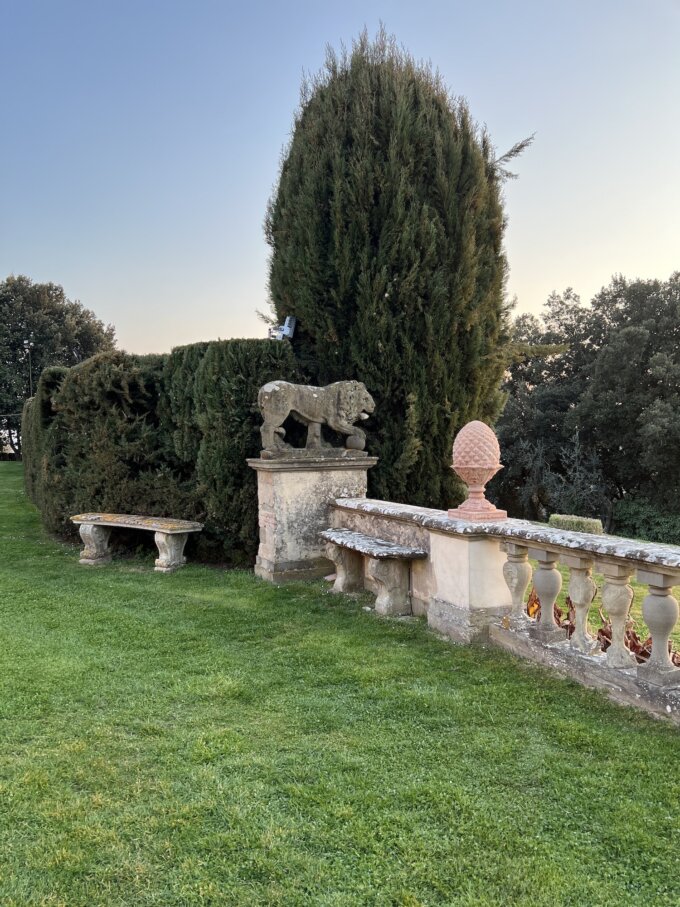
The AntePrime Toscana program is the most exciting way for international journalists to taste the region’s wines and make notes on the new vintage. Yet it is also the best way to discover the “hidden gems” responsible for the wine industry as it exists today.
For example, the Carmignano DOCG is a new-to-me region that I have read about in wine books, yet had never visited.
The AntePrime Toscana program enabled me to visit the region in virtually the same way as the Medici family had back in 1596.
Well, not quite–but close.
In that year, Ferdinand I de’ Medici saw the rolling hills of Carmignano and the beautiful sunset and built his hunting lodge here. I’m suspecting that he may have also tasted the wine of the region while in the area.
The ”hunting lodge” he built, pictured below, became the family summer estate.
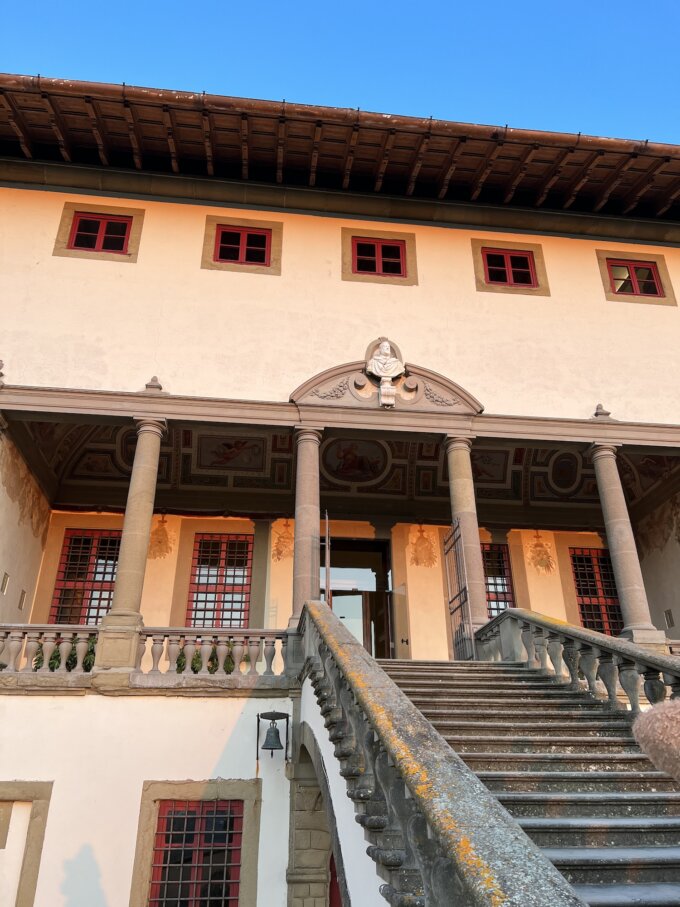
Tenuta di Artimino–Medieval Days to Present
In 1935, Giuseppe Olmo–known by all as Gepin–went down in history by setting a new Hour Distance Record in international cycling.
In those days, international sports figures probably didn’t have the same “influencer” status as they do today, nor the millions of dollars in endorsement fees. And to make his dream of owning a world-class, wine-producing castle estate more difficult, he came from a family of modest means.
Yet “Gepin” knew the value of hard work, sacrifice and tenacity. And he must have also possessed more than a modicum of charm, for he could purchase Tenuta di Artimino in the 1980s.
Yet (nearly) a half-century ago, the castle was nothing as it is today. By various accounts, the roof had been bombed in the second world war and never repaired.
Slowly, he was able to rebuild it into the masterpiece it is today, now an UNESCO World Heritage Site known as the Medici Villa La Ferdinanda.
The New Generation

Annabella Pascale, CEO, is the granddaughter of Giuseppe Olmo and our guide on this tour. Through her eyes, we could see that this land has been a true cradle of arts, good living, and wine for centuries,
Before the formal tasting of the house’s excellent wines, she gave us a tour of the house and told more than a few stories. The history of the Carmignano Docg wine begins with the Etruscans, who already produced wine in these areas millennia ago. They had found wine vessels in the area inside some Etruscan tombs. And no doubt, some remain buried deep in the earth, perhaps near the Tenuta di Artimino vineyards itself.
Carmignano History
One of the first documents on the wine production of these hills dates to 804 A.D. It was the time of the reign of Charlemagne and his son, Pippin. A parchment dating from this period, written in Latin, reads that the church of San Pietro a Seano granted some land in use with a system of dividing the harvest that can be considered an ancient form of sharecropping.
In the 1400s, merchant Francesco Datini placed fifteen large orders of Carmignano wine for his wine cellar, paying more than the going price for the most prestigious wines of the time.
The poet Domenico Bartoloni wrote a verse saying that while “while French wines such as the Claretto di Avignone may be good, and Chianti has nothing to complain about, the wine of Artimino and Carmignano are in a class by themselves.”
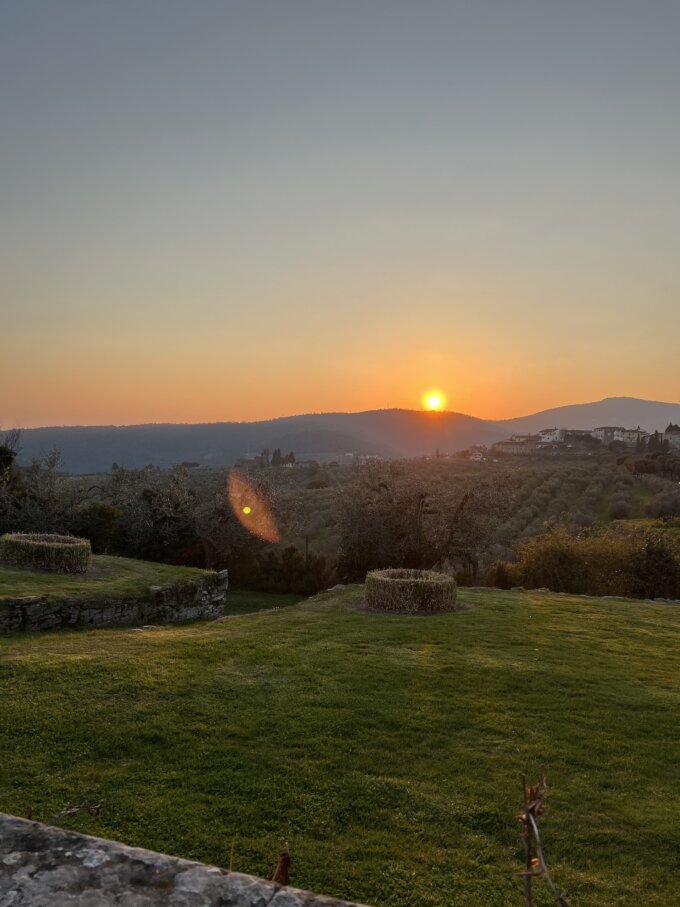
The Tutored Tasting
Filippo Paoletti, enologist, lead the tutored tasting in the formal dining room. The long table was beautifully set with the finest crystal glasses to better taste the wine.
Journalists tasted the 2018, 2017, 2016 and 2015 vintages of the iconic wine Grumarello, produced with varying amounts of merlot, cabernet sauvignon. Mr. Paoletti had an encyclopedic memory of the vintages. We also tasted several of the Poggilarca Carmignano DOCG wine.

The Grand Dinner
In true Medici style, the grand dinner took place at a long table in the barrel room.
It was a fun event. Our hosts set up a first course buffet in what looks to be the original (but restored) historic kitchen, complete with a hearth for cooking.
After choosing the first course, they served guests a delicious entrée and dessert at the table.
Many thanks to Annabella Pascale, the Carmignano consorzio, and the people at AntePrime Toscana for making this visit possible.
March 22 Chianti Classico Collection at Stazione Leopolda
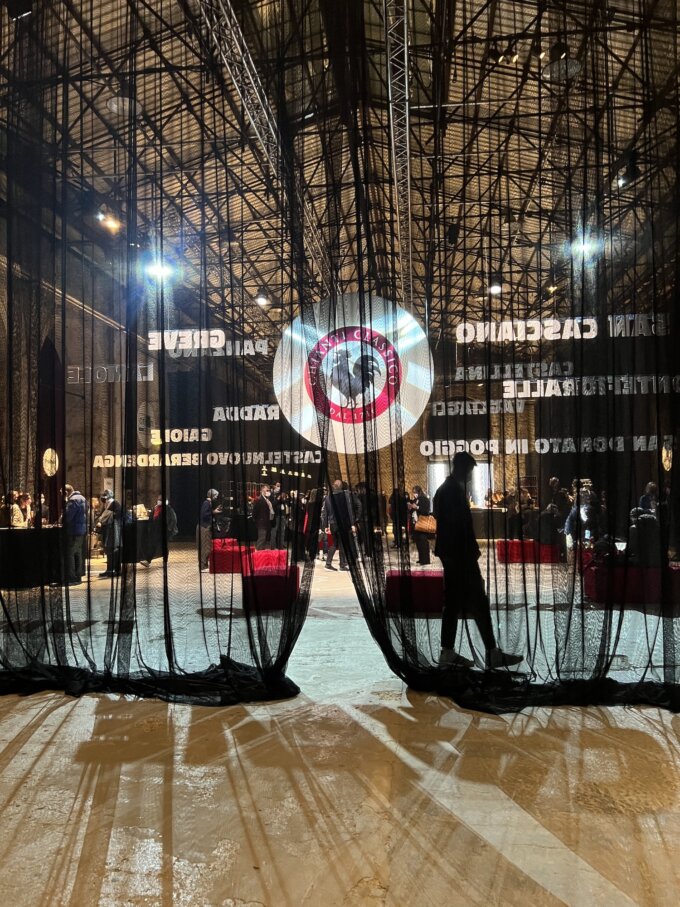
Stazione Leopolda was the first train station in Florence. Completed in 1848, it was named “Leopolda” in honor of the reigning Grand Duke.
The train station motif was appropriate given the speed-tasting element of the day-long Chianti Classico tasting.
In all honesty, the tasting event was all self-paced – wine journalists can taste as fast or slow as they desire.
As was the case in virtually all the tasting events, professional Italian sommeliers served the wines.
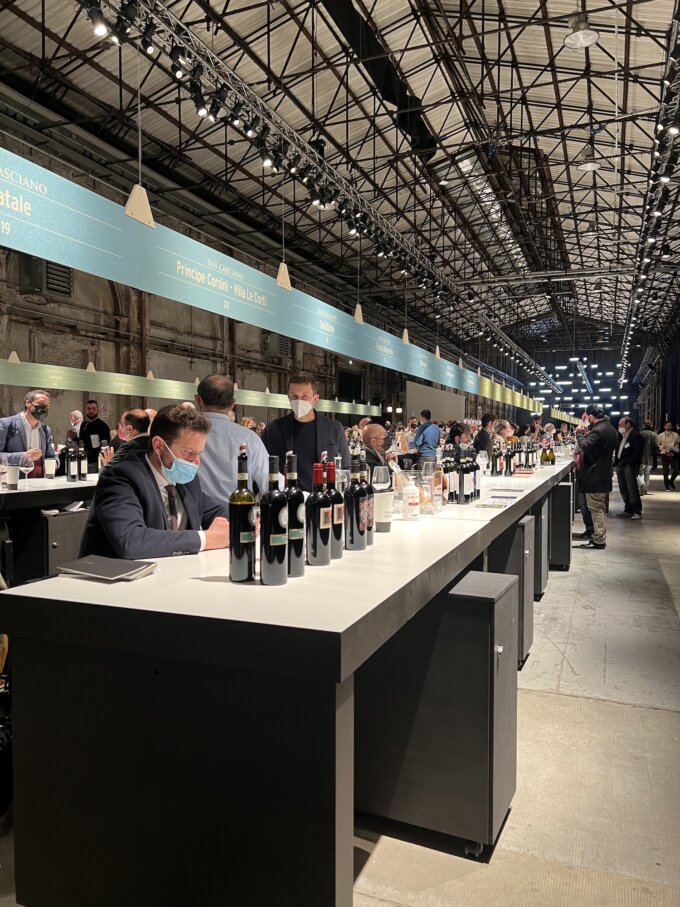
During this Chianti Classico tasting, everything was electronic. Journalists would order the wines from their desks via their computer or device.
In addition to the Preview tasting of the latest vintages of Chianti Classico wines in three typologies (Annata, Riserva and Gran Selezione) journalists could visit the stands of 200 producers.
Tasting of Chianti Classico D.O.P Olive Oil from the 2021 harvest was also available.

One of the highlights of the day was the tasting and presentation of wines as old as 1949.
Accompanying this fine, once-in-a-lifetime tasting was a visual presentation of the current events in the year they made the wine.

March 22 Dinner at Osteria Dell’Enoteca for the Chianti Classico Collectiion 2022
The AntePrime Toscana 2022 Committee had a great idea in organizing several “small table” dinners for the international journalists attending the week-long event, in which they mix with producers on a more intimate basis.
The restaurants were assigned to journalists in advance, and we were instructed to meet a representative at a specific street corner near our hotel.

My restaurant turned out to be Osteria Dell’Enoteca, a restaurant so wine focused that galestro rocks (a grey porous rock found in Chianti Classico vineyards and elsewhere) were used as a motif in its décor.
Though the producers at my table spoke halting English, wine became the universal language and we were all able to make ourselves understood.
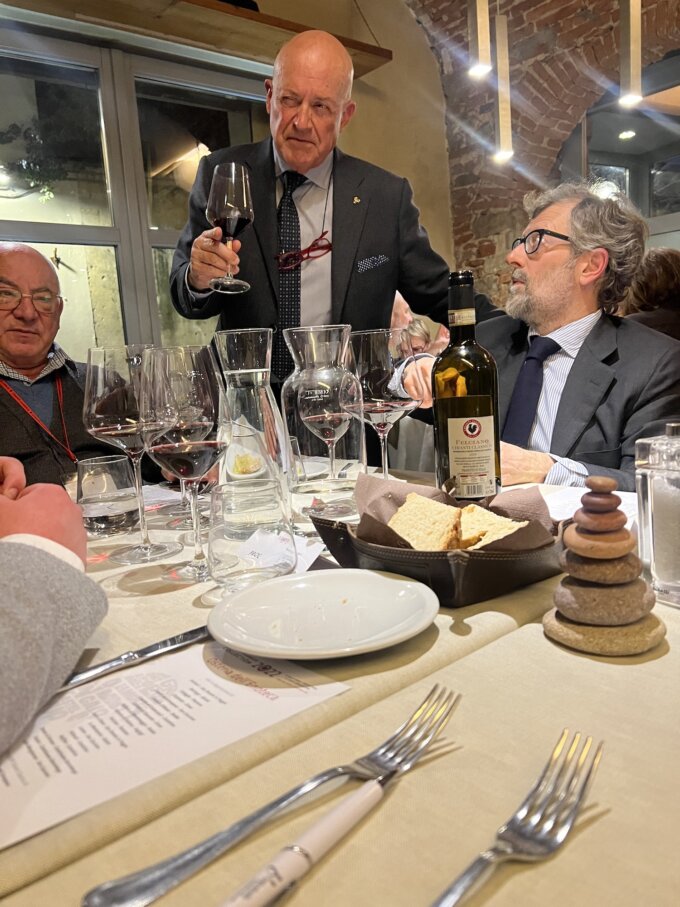
March 24: Vernacchia Technical Tasting at Museum of the Modern and Contemporary Art De Grada
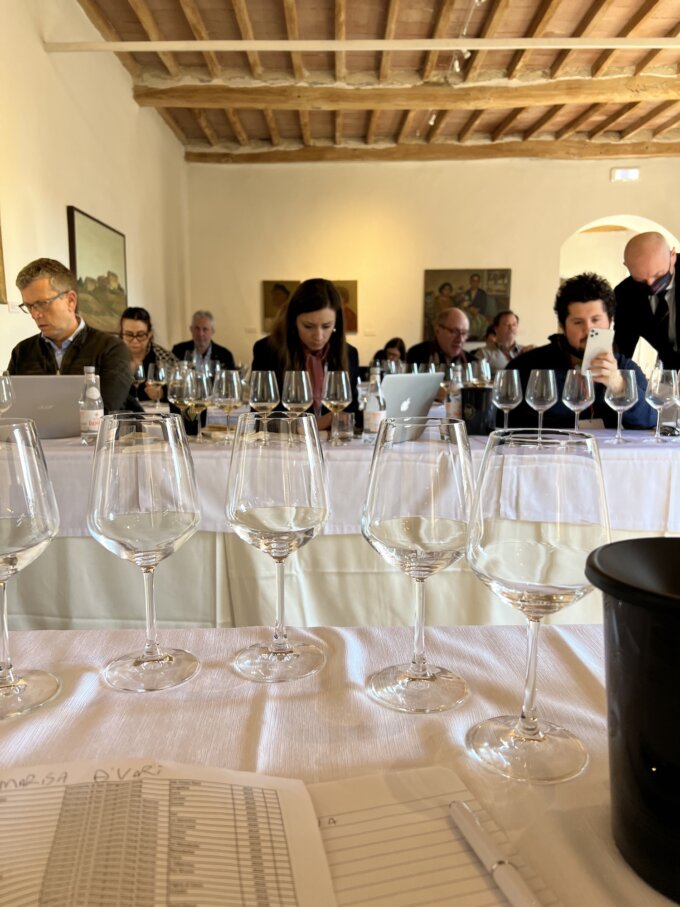
The foucs of the day was the technical tasting of the new vintages of Vernaccia di San Gimignano D.O.C.G 2021 and Vernaccia di San Gimignano Riserva 2020 with sommelier service
March 23 & 24 Meals with Vernaccia di San Gimignano Producers
History of San Gimignano
San Gimignano got its start in the third century BC as a small Etruscan village. It grew in importance as it sat on an important trade route between Italian cities. Many residents grew rich and built tall towers to showcase their wealth. These many towers lend itself to its moniker as “medieval Manhattan.”
The black plague in 1348 ended the town’s prosperity.
But the rise of interest in wine and tourism has raised its sails once again. Until Covid hit, millions of people would clog the stone-paved streets all summer long.
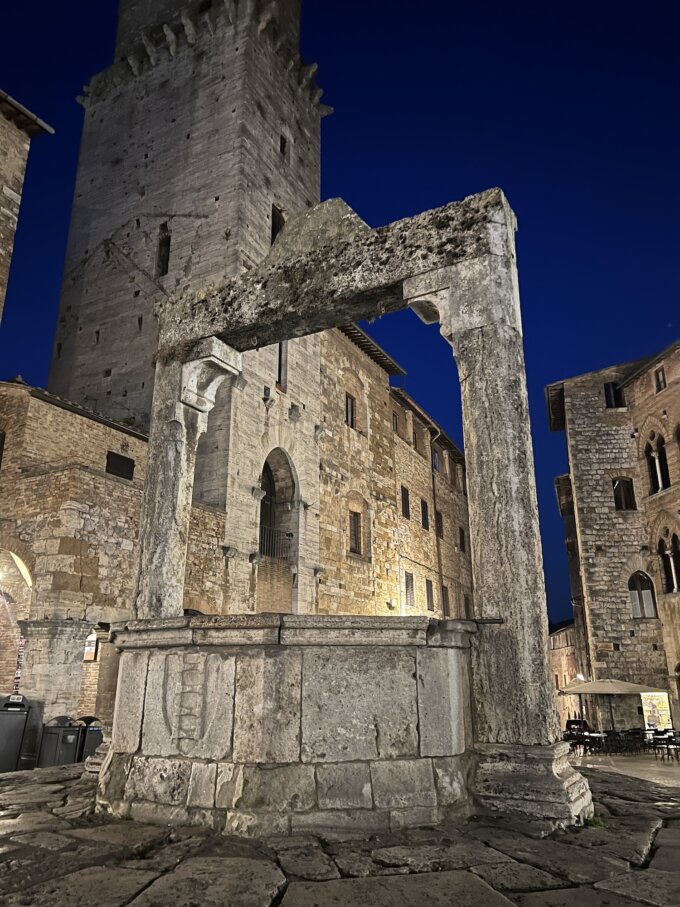
When I first began my adventure to get the Wine & Spirits Educational Trust Diploma, I remember sitting in a classroom of the International Wine Center, The year was 2008, I remember a golden liquid poured in “blind fashion” into my glass.
Raising it to my lips, I had never encountered such a wine before. It had a tangy, almost saline minerality, a striking rich texture, and offered a sensuality rarely encountered in a white wine.
What was it?
The answer was overnice di Gimignano, a Tuscan wine that has the honor of being the only DOCG wine region in Italy. I loved its texture, and that sultry hint of saffron and the subtle aroma of melted butter.
I looked at the picture of the walled city of San Gimignano in my textbook, and wondered if one day I’d be lucky enough to visit.

The People Behind the Wine
Thanks to the excellent planning of the AntePrime Toscana team, I was able to meet four San Gimignano producers, all of different ages, circumstances, and attitudes.
Dinner with Producers
My first dinner took place at the historic La Cisterna hotel in the middle of the city. As you may imagine, a cistern sat right in front of the hotel. And by chance, my room overlooked it.
At dinner, I warmly greeted my two producers hosts, both of whom happened to be named Lorenzo.
Lorenzo Rosi of Mareterra and Lorenzo of Casa Lucii.
They brought several samples of their wine, and explained how the call for a fresher, lighter style of Vernacchia San Gimignano is now demanded by the market.
Lunch with the Producers
The following day I had lunch with two different producers, Fornacelle and Tolena. Both producers offered the rich, riserva style I loved in addition to their lower tier, more simple styles.
Both producers also offered tasting events at their wineries, and rooms that guests could rent.
March 24: Grand Dinner Montepulciano Fortress of Montepulciano

Sommeliers stood ready to pour any request from a very long list of regional wines.

March 24: Comparative tasting of the new vintages of Vino Nobile
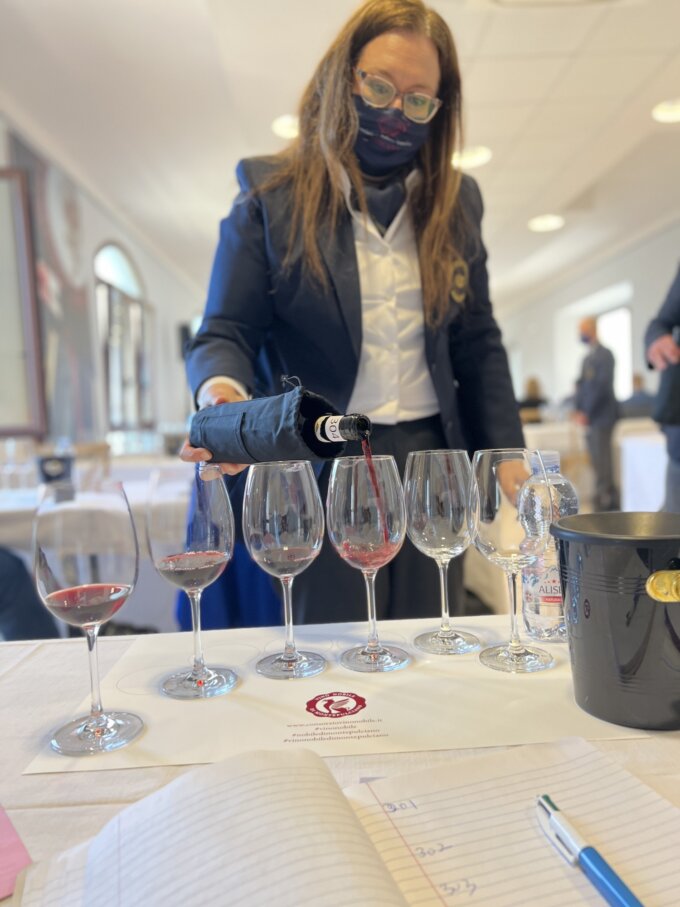
Like the other tastings in the Anteprime Toscana program, this was request for wine on demand.
March 24: Private Visits to Montepulciano Producers
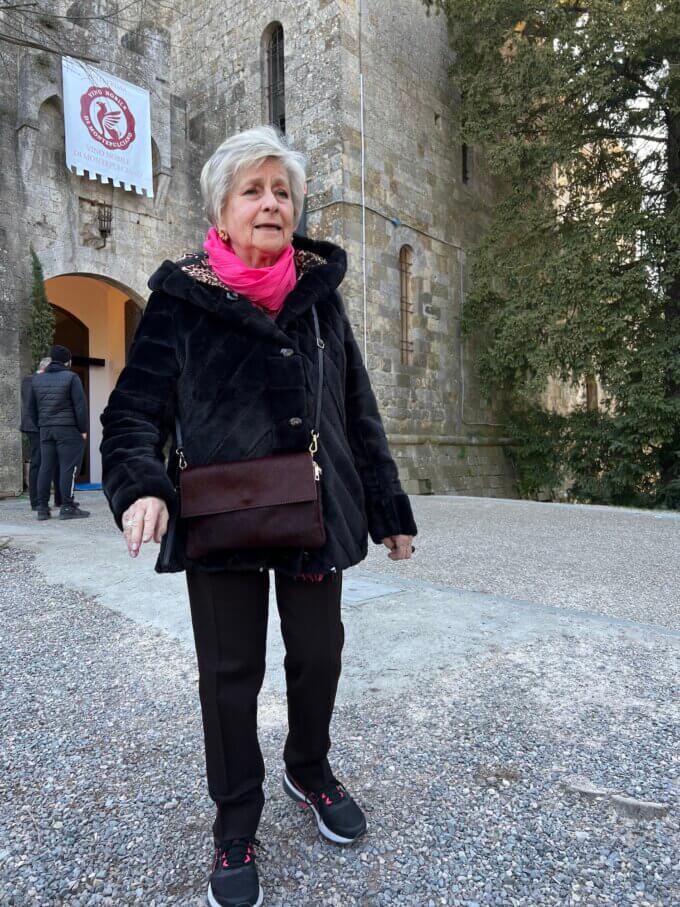
The first visit was to Villa St. Anna
The Villa S. Anna winery is part of a larger property owned for about two hundred years by the family of Simona Ruggeri Fabroni. It is situated on the hills around the town of Montepulciano, renowned for its fine wines.
For many years Simona (in the photo) has been committed to upholding the ancient, passionate family tradition of promoting and selling fine quality wines, with the help and encouragement of her daughters Anna and Margherita.
During our visit, she showed us the near-200 year old cellar and gave an excellent tasting of her very best wines.
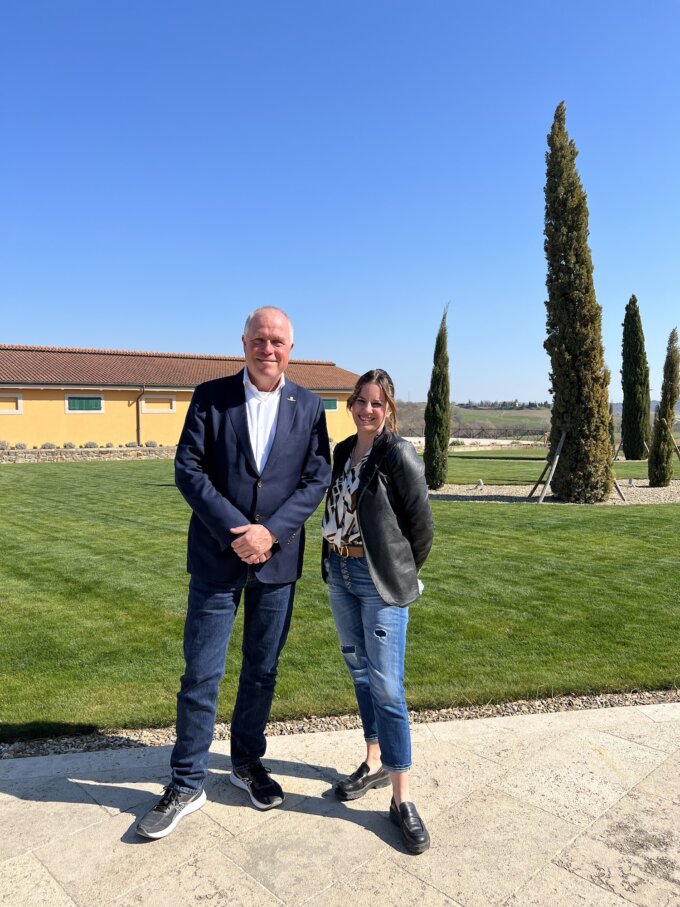
The photo above shows the owner posing with his new young winemaker, the daughter ofthe previous winemaker.
Carpineto offers wine tasting to guests, visits, and even has a museum. There are many artifacts in the area from the Etruscan days.

March 25: "The Other Sangiovese" Presentation by Gabriele Gorelli Master of Wine
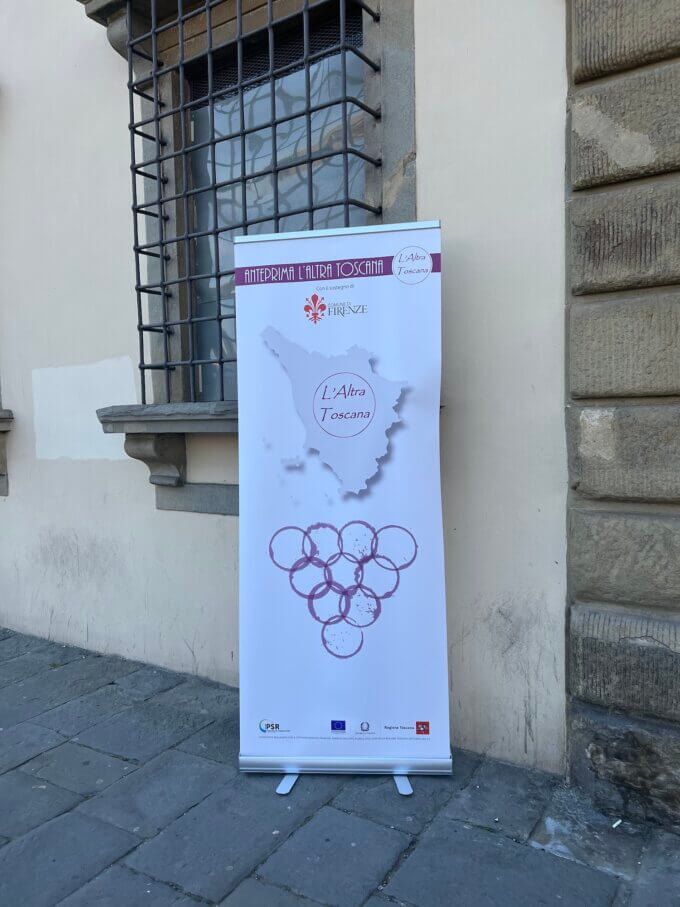
On this day, international journalists gathered at the Santa Maria Novella Museum, near the church of the same name. This was a luxurious and rich historical venue for another landmark tasting.
Journalists from various corners of the world gathered to taste and score wines from the following regions: Carmignano, Chianti Rufina, Colline Lucchesi, Cortona, Maremma Toscana, Montecucco, Orcia, Terre di Casole, Terre di Pisa, Valdarno di Sopra.
The format was for journalists to sit and specifically assigned places in round tables. The format was digital: journalists would choose their selection of wine to be served in a flight from a booklet.
A classically dressed Italian sommelier would take the wine order and bring it quickly.
Given the vast amount of wines and regions to be tasted, my personal observation was that the process was fast and virtually flawless.
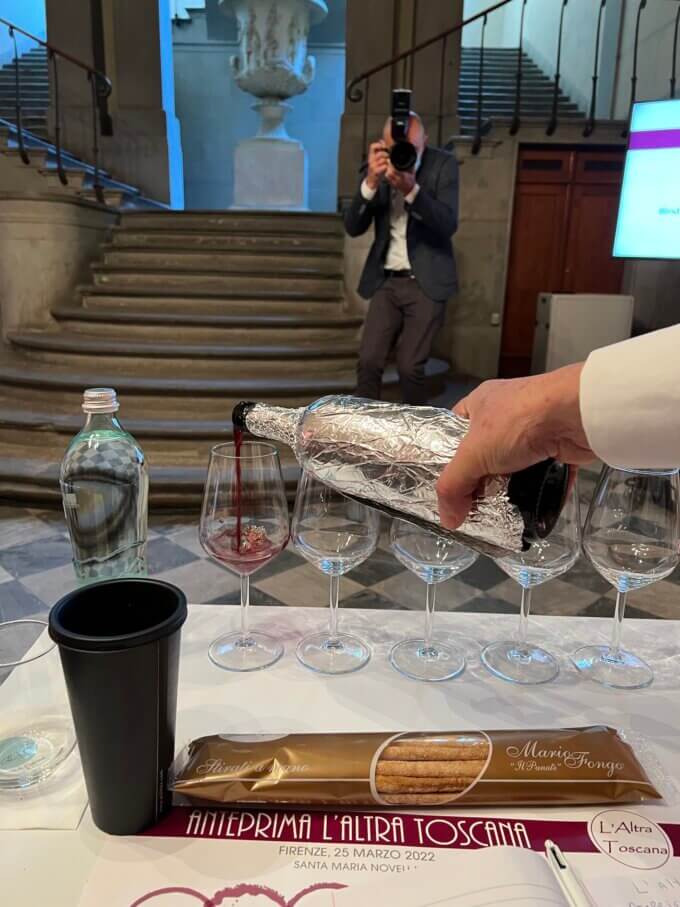
Gabriele Gorelli Masterclass

Mr. Gorelli MW (the initials refer to the Master of Wine) offered three diverse masterclasses on this day. Seating was limited, and given the brilliance of the presentation and rarity of most of the wines, I was thankful I registered for these magnificent, sold-out events in advance.
The word “magnificent” is used due to the creativity required to conceive each of these three masterclasses, then finding the appropriate wines to underscore their theme.
Rarity and Distinction
Mr. Gorelli is to be commended for the time and focus he devoted to discovering these Tuscan treasures. Even the most seasoned wine connoisseurs with the richest wallets may not have been able to procure them.
His ability may be to the rigorous discipline of the Master of Wine Program, or that Mr. Gorelli can trace his wine roots back to his grandfather, a producer of Brunello di Montalcino.
"The Other Sangiovese " - Blind tasting dei Cru di una Toscana da scoprire
In this session, Mr. Gorelli gathered prime examples of Sangiovese from lesser-known regions. With Mr. Gorelli as our guide, we first tasted the wine blind (without knowing the region or winery) and discussed its distinctive points.
The wines are listed below.
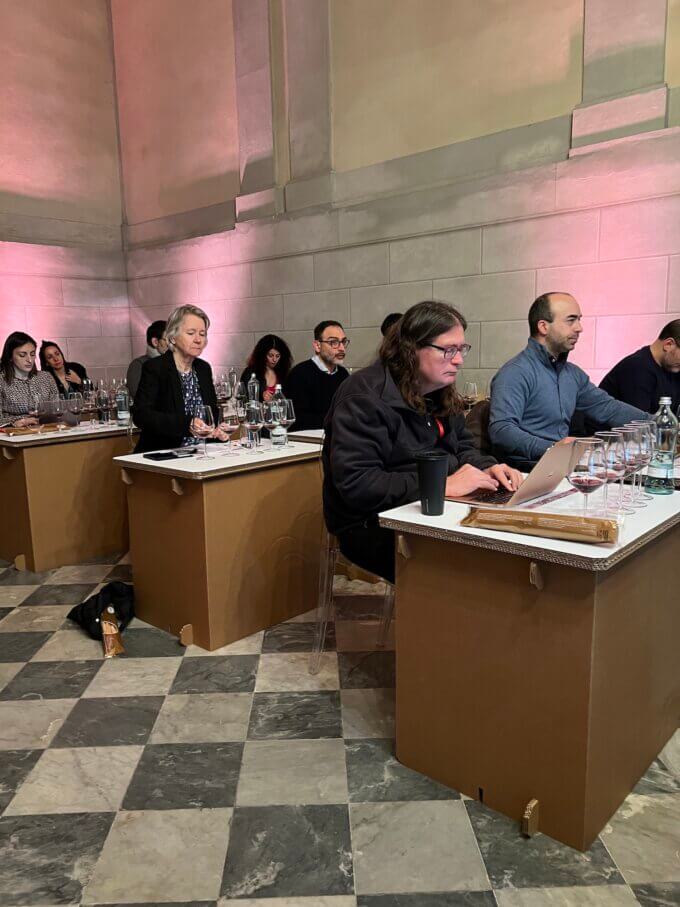
1. Ambra 2018 • Consorzio: Carmignano •
I’ll make a note here that the Carmignano DOCG region is an exciting discovery on this visit. Check out a related article about our visit to a Medici castle in the Carmignano DOCG region.
But for now, here’s its history: Carmignano had been identified by Cosimo III de’ Medici, Grand Duke of Tuscany as one of the superior wine producing areas of Tuscany and granted special legal protections in 1716.
In the 1800s, the producers of the Carmignano region developed a tradition of blending Sangiovese with Cabernet Sauvignon, long before the practice became popularized by the “Super Tuscan” of the late 20th century.
2. Atrium Sangiovese Riserva 2016 • Consorzio: Orcia
I was pleased to sample this wine blind as I had visited Orcia a few years earlier. Here’s a link to my Forbes article about this undiscovered region.
Like most of Italy, Orcia is characterized by medieval castles, ancient villages, charming farmhouses, and unpaved roads lined with cypress trees, During my visit, I stayed in a rustic inn and a plush castle – this is the dichotomy of Orcia. You will also find a more rustic style of Sangiovese and a style with more elegance, as Mr. Gorelli showcased with the Atrium Riserva.
3. Il Pozzo Rufina Riserva 2017 • Consorzio: Rufina
I noted high acidity in this wine, likely because the vineyards sit on the hills of the western side of the Sieve river at “Il Pozzo” above the town of Rufina (Florence) at 300 meters elevation.
4. Fubbiano Riserva 2019 • Consorzio: Collene Lucchesi
I liked this wine from a lesser-known region for is concise aromas and flavors of morello cherry. It’s also distinctive in having a generous amount of Canaiolo e Ciliegiolo graprd.
5. Collemassari Poggio Lombrone 2016 – Consorzio: Montecucco
Montecucco is one of the newer DOC regions. Wines can range from the rustic spectrum of Sangiovese to the more elegant, as is the case with this example. Vineyards are planted at a higher altitude, resulting in more acidity. You will notice a structural firm character in the wine, partly due to spending 34 months in a mix of French and Slavonian oak.
6. I.s.i.s. Angelo Vegni Sangiovese 2017 • Consorzio: Cortona
In tasting this wine, Mr. Gorelli noticed that there is “shape on the palate.” He also remarked that good Sangiovese can be made in a lighter style.
7. Badia di Morrona Vignalta Sangiovese 2016 • Consorzio Terre di Pisa •
100% Sangiovese, this wine boasted sweet cherry vanilla aromas and flavors, again made in the lighter style. Mr. Gorelli described it as a “playful” style of Sangiovese. The wine spends 24 months in oak.
8. Stebbi Podere di Casole 2018 • Consorzio: Terre di Casole
Mr. Gorelli revealed that grapes for this wine is grown on lava soil. It manifests as a lighter style of Sangiovese, and can almost be compared to a Pinot Noir in terms of its delicacy.
9. Petrolo Boggina C 2019 • Consorzio: Val d’Arno di Sopra • Denominazione: DOC VAL D’ARNO DI SOPRA SANGIOVESE VIGNA BÒGGINA RISERVA
This wine comes from Organic vineyards, made from 100% Sangiovese grapes. The vineyard was planted in 1947 by Gastone Bazzocchi, father and grandfather of the current owners. The winery has a biological certification.
10. Valdonica Baciòlo 2018 • Consorzio: Maremma
Mr. Gorelli described this wine as having a “pure and juicy style” and a great deal of expression.
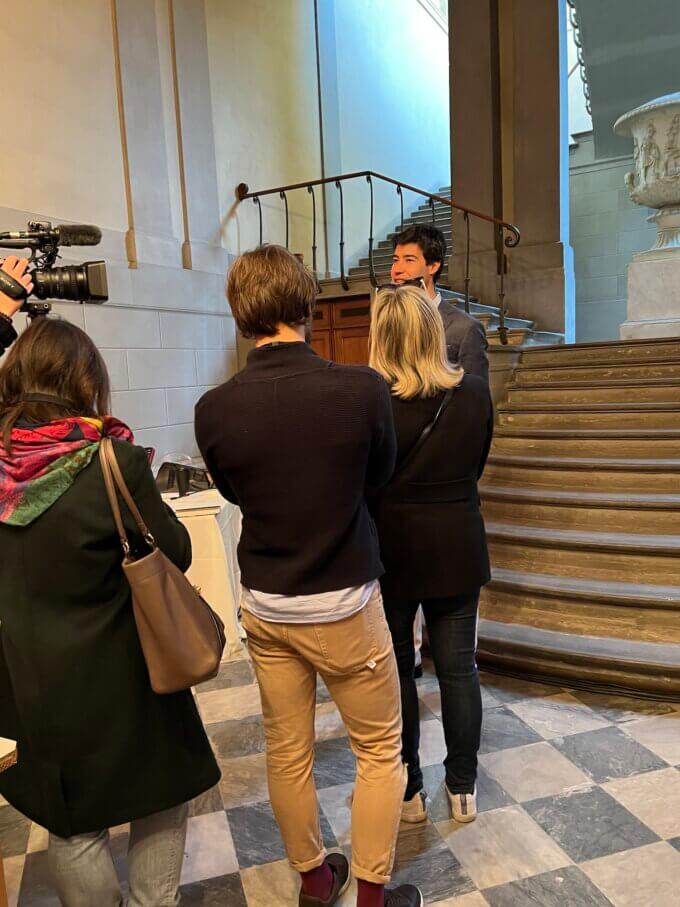
The Value of Time Seminar
This closing session saw Mr. Gorelli presented ten wines, some over 40 years of age, still delicious and holding their own.
As you can see from the photo below, this session created quite a sensation. Why? Perhaps because outside of a few key regions celebrated by collectors, most “simple” Sangiovese wines are not expected to age.
Yet here we are, over forty years after the Selvapiana and Villa Capezzana wines were bottled, they expressed themselves well for the wine connoisseurs in attendance today.
1. Selvapiana Chianti Rufina Riserva 1980
2. Villa di Capezzana 1981
3. Podere Forte Petrucci 2008
4. Pietro Caciorgnia Le Macchie 2010
5. Campi Nuovi Sangiovese Riserva 2012
6. Fattoria Varramista Frasca 2010
7. Tenuta Belguardo 2008
8. Tenuta di Valgiano 2013
9. Poggio Sorbello Gortinaia Syrah 2014
10.Podere il Carnasciale Caberlot 2013

Overall Impression
Conducting a tasting of ten hand-selected wines per masterclass, each designed to represent “the other Sangiovese” in less than an hour, was quite a challenge.
Mr. Gorelli kept within his time frame, keeping the presentation moving as he introduced one fascinating wine after another.
The professional Italian sommeliers, smart in their gold-braid accented uniforms, worked efficiently in tandem with his presentation.